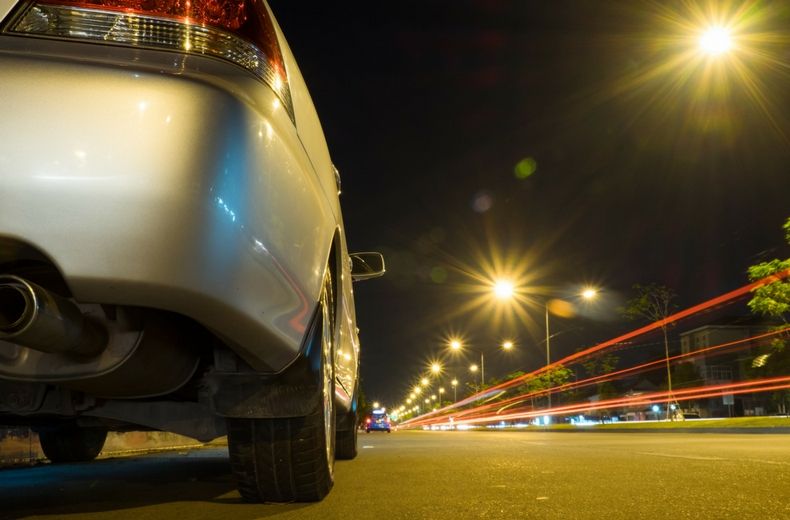So when exactly do you need to use your parking lights, and what could happen if you don’t?
What are parking lights?
In the UK, we use the term sidelights to describe the small lights found in the front corners of your car, usually within the headlamp unit itself.
Sidelights aren’t as bright as headlights, so are used by drivers to make themselves more visible to other traffic during times when it’s not dark enough for main lights.
But they also have a second purpose - as parking lights - and in certain situations the Highway Code states you should leave them on, even once you’ve left your parked car.
It’s crucial you know how to check your lights and bulbs in case one stops working.
When sidelights are turned on; two rear tail lights, the number plate lights and those at the front of your car must all be illuminated.
How do I use parking lights on my car?
Almost all light switches in modern cars are either mounted on the dashboard, to the right-hand side of the steering wheel, or on the end of the indicator stalk.
Your parking lights can be switched on and off by rotating the dial into the correct position, or pressing a button depending on the car.
There will usually be a position for sidelights, headlights and usually a separate button or switch to activate your fog lights.
Although not standard, some vehicle models allow the driver to incorporate the use of their indicator when leaving on their parking lights.
So if the indicator is left in the downward position when the engine is turned off, the sidelights will automatically show up only on the left-hand side of the car.
What does the law say about parking at night?
If your head hasn’t been buried deep in the Highway Code recently, it’s worth the reminder of section 249 that states vehicles must display parking lights – sidelights – when parked on a road (or lay-by) with a speed limit over 30mph.
If the road has a speed limit of 30mph or less, you don’t need to leave on your sidelights, as long as:
- your spot is in a recognised parking bay or lay-by, or
- you’re facing in the direction of the traffic flow, close to the kerb, and at least 10 metres (32 feet) from the nearest junction
Of course, as always, make sure you’re complying with any local parking restrictions, as instructed on the roadside.
Sidelights must also be switched on if your vehicle, for unavoidable reasons, is parked on any road in fog.
Parking at night on a 30mph-plus road

If a road operates a speed limit greater than 30mph, under The Road Vehicles Lighting Regulations 1989 you’re legally required to leave on your sidelights when parking on it at night.
The best thing to do is to avoid parking on these roads altogether, finding an alternative spot where possible.
According to the Government, you must not park on a road at night facing against the direction of the traffic flow, unless in a recognised parking space.
Parking at night on the right-hand side of the road is never allowed, except on a one-way-street.
What classes as a parking bay?
The Highway Code states that recognised spaces or bays are ‘marked out with white lines on the road as parking places’.
These aren’t typically found in residential areas.
But as speed limits here will be under 30mph, you can still park without your lights as long as you meet the other criteria.
On roads with a speed limit less than 30mph, lay-bys are also classed as acceptable spaces.
Do the same rules apply for all vehicles?
As long as they follow the qualifying rules, these vehicles don’t need to leave on sidelights when parking at night on a road with a speed limit of under 30mph:
- cars
- goods vehicles (under 2500kg unladen weight)
- invalid carriages
- motorcycles
- pedal cycles
All other vehicles and trailers – and all vehicles with projecting loads – must not be left on a road at night without lights.
- Parking guide - where can and can’t you park?
- Engine idling - why it' so harmful and what's being done
- Traffic wardens - know your rights
Are these parking laws always enforced?
The use of sidelights for parking is seen by some as a classic example of a grey area in the law, with a common sense approach often applied by the authorities.
But the reality is that these laws exist and should always be followed.
Failure to comply with the Road Vehicles Lighting Regulations 1989 when parking at night absolutely makes you eligible for a non-endorsable penalty charge notice – with a regionally-determined fine applicable, usually reduced if paid off within 14 days.
These fines typically range from £35-£75.

Cheaper than AA or we’ll beat by 20%^
• Roadside cover from £5.49 a month*
• We get to most breakdowns in 60 mins or less
• Our patrols fix 4/5 breakdowns on the spot

But I never see cars parked with their lights on…
It does feel like a fairly rare sight. And to some extent many car and van drivers choose not to follow these parking laws to the letter – particularly in more obviously residential areas – believing the police to be fairly lenient as long as common sense has been applied, and no obstructions caused.
In fact, the law doesn’t apply to as many roads as you might think.
If in doubt, for the sake of staying safe and legal, always follow these parking laws.
Will leaving my parking lights on give my car a flat battery?
Unlike headlights, sidelights operate on a low wattage and are designed to be able to withstand being left on for longer periods without draining your vehicle’s battery. A few hours shouldn't be a problem, but cars with older batteries might struggle with an overnight stop.
For a rough guess as to how long you can safely leave on your sidelights, find your vehicle’s amp-hour rating.
Then divide this figure by 2.5 to get an approximate number of hours.
For example, a battery rated at 80 amp-hours, should in theory be able to handle 32 hours of continuous sidelight use, although this is never advised.
Ideally, you’ll return to your parked vehicle as soon as possible after sunlight returns, to minimise any risk of drainage, and never leave your headlights on.
In fact, it’s an offence to leave them on while stopped on the side of the road, as they can dazzle oncoming drivers.
Check out our range of parking products on RAC Shop.










